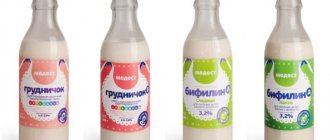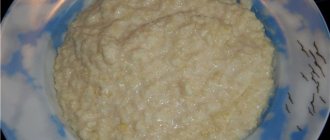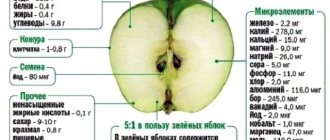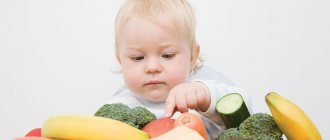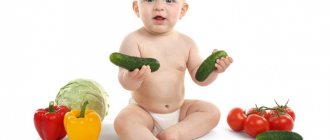At 6 months, the child’s horizons, attention, and needs become broader. The same thing happens with the diet. It is becoming more diverse. Previously, doctors advised starting complementary feeding at almost one month of age. Today their opinion has changed, they recommend changing the child’s menu at 6 months. As a rule, the baby’s diet during this period becomes more varied. Up until this point, he had only been drinking breast milk or formula.
If the child is sick or has recently been vaccinated, then it is better to postpone complementary feeding. Otherwise, his parents won’t even know why he has a fever. Now we’ll find out what a child’s menu should be at 6 months.
Introducing new products: advice for young mothers
Mostly during this period we start giving vegetable purees. You can, of course, give fruit ones too. But then the little one will refuse to eat more nutritious dishes after eating sweets. To avoid allergic reactions and rashes in your baby, you must first give half a teaspoon of puree.
It is advisable to introduce complementary foods in the morning. If your baby develops a rash or something suspicious, you can take action immediately; this is quite difficult to do at night. Before giving your child a new food, it is necessary to study what allergic reactions certain vegetables can cause.
If everything is fine, then the dosage should be increased by a couple of teaspoons over the course of a week. You cannot introduce two or more new dishes into your baby’s diet at once. Let him get used to one first, after 2 weeks to the second, and so on. The first complementary food should be very finely chopped, then you can do it with small pieces (but very gradually) so that the child does not choke while eating.
Rule #2. We start with porridge.
Which porridge should I choose? Pediatricians around the world advise starting with gluten-free cereals, such as buckwheat, rice and corn porridge. Why is gluten dangerous? In a nutshell, these are abdominal pain, bloating, diarrhea, as well as an allergic reaction in the form of a skin rash and many other various unpleasant symptoms. I hope I’ve convinced you, we’ll put off gluten porridge for later. What does introducing complementary foods look like? We start giving any new product with 1 teaspoon to assess the child’s reaction to it. If stool and sleep are not disturbed, and the skin remains clean, we gradually increase the amount of porridge eaten and bring it to a full portion, replacing one feeding with breastfeeding or formula, that is, up to 200 ml.
Lean meat
After getting used to vegetables, your child can be offered lean meat. It also needs to be crushed and added to soups or purees. What can you give a 6 month old baby from meat? Veal and turkey are perfect for new complementary foods. You can cook soup for your baby using broth from this meat. Just first you need to strain it very well so that there is no fat. Every child will like veal or turkey. Making meat puree is not at all difficult. For example, veal needs to be cleaned of excess film, washed in plenty of water, cut into pieces and simmered until cooked.
A blender does not always grind meat well, so it is better to grind it 2-3 times through a meat grinder. After this procedure it turns out quite dry. To prevent the child from choking on it, you can pour a little broth to the desired consistency. Then put on low heat and bring to a boil. You need to add very little butter - 1-2 grams. A child's menu at 6 months gradually becomes more varied and balanced.
Recipes for children from 6 months to one year
6 months zucchini puree 1 small zucchini 1 small potato 1 tsp. olive oil or milk Peel the vegetables and steam them. Make a puree, season with olive oil or milk.
carrot and zucchini mousse 120 gr. carrots 150 gr. zucchini 1 coffee l. vegetable oil Cut the vegetables into small cubes and steam. Grind to a puree, add oil. In this way, puree can be made from all vegetables: carrots, zucchini, squash, cauliflower, broccoli, white cabbage. The finished puree can be frozen: transfer the puree into ice cube trays and freeze in the freezer. Pour the frozen puree cubes into bags, writing the composition and date on them. You can store these cubes for a month. 30 minutes before meals, put 2-3 cubes in a bowl and place in hot water. 7 months
apple and pumpkin puree with porridge 150 gr.
pumpkin 1 apple 1.2 tsp. fructose 1 tbsp. cereals (oatmeal, buckwheat, rice) 1.2 tbsp. milk salt Peel the pumpkin and apple, cut into pieces and steam. Cook porridge. Pass the pumpkin and apple through a meat grinder or sieve, add 1 tsp. fructose, bring to a boil. Cool the puree, add butter. Add puree to porridge. Antonovka puree soup with rice 100-150 gr. apples 1 tbsp. rice 1 tbsp. fructose 4 g cinnamon Bake the apple without the core in the oven. Cool, remove the skin, rub through a sieve. Boil 1 glass of water, add 1 tsp. fructose, cinnamon and rice. Boil until done. Rub the rice through a sieve and mix with applesauce. Add the remaining fructose, beat, let it steam. rice porridge 250 gr. milk 2 tbsp. fructose vanillin 1.2 cups rice raisins Mix milk and fructose in a saucepan, add raisins, vanilla, bring to a boil. Add rice to boiling milk and cook. Cool. You can replace raisins with dried fruits or fresh fruits. potatoes and pumpkin 70 g potatoes 70 g pumpkin milk Boil diced vegetables in 300 ml. Water over low heat. Beat with a mixer. Dilute with milk, add butter. You can add cottage cheese or orange juice. 8 months
rice pudding with fruit 50 gr.
rice 100 ml. milk 100 ml. water 2 quail eggs 12 gr. fructose 15 gr. raisins 20 gr. candied fruits 5 gr. butter Cook milk rice porridge. Add egg yolks, washed raisins, chopped candied fruits and pour in the beaten whites. Place in a greased pan and bake in the oven. pumpkin and apple pudding 200 gr. pumpkins 130 gr. apples 20 gr. boiled rice 10 gr. fructose 20 gr. sour cream 1 quail egg Grate pumpkin and apples on a coarse grater. Mix with rice, fructose, sour cream and beaten egg. Place in a greased pan and bake in the oven. vegetable puree turnip potatoes carrots peas spinach green onion olive oil parsley Stew everything in oil and water until soft. Beat in a blender or mince several times and add salt. blackcurrant jelly 6 tsp. currants 4 tsp. fructose 1 tsp. potato flour 200 ml. water Squeeze the currant juice, cook the juices for 5-10 minutes, strain. Add fructose to the broth, bring to a boil, pour in flour diluted in cold water and squeezed juice. Cool. cranberry drink 4 tsp. cranberries 4 tsp. fructose 200 ml. water Squeeze cranberry juice, cook the juices for 5-10 minutes, strain. Add fructose to the broth, bring to a boil, pour in flour diluted in cold water and squeezed juice. Cool. dried fruit compote 4 tbsp. dried fruits 1.5 tsp. fructose 320 ml water Boil dried fruits, rub through a sieve, add fructose to the compote, bring to a boil, cool. 9 months
vegetable puree soup 120 gr.
meat (chicken, lean veal, beef) 200 gr. potatoes 400 gr. young carrots, greens. Mince the meat, pour in 0.5 l. water and cook for 1 hour. Boil vegetables, chop. Strain the meat broth, add vegetable puree, and boil. chicken with apples 1 apple 1.2 chicken breast fillet 1.2 tsp. butter 1 tsp. lemon juice Peel the apple and cut into pieces. Finely chop the chicken fillet. Simmer the apple in a small amount of water. Stew chicken in water and butter. Mash the apples with a fork, mix with chicken and lemon juice. pumpkin with nutmeg and veal 20 gr. veal tenderloin 100 gr. pumpkin olive oil nutmeg Finely chop the meat and pumpkin, place in a frying pan, add water, olive oil, sprinkle with nutmeg and simmer for 15 minutes. Grind in a meat grinder. You can use chicken or turkey instead of veal. chicken soufflé chicken 1 egg white bread 3 tbsp. milk 1 tbsp. l.butter Cook chicken meat without salt. Pass the finished meat through a meat grinder. Soak the pulp of white bread in 1-2 tbsp. warm milk. Pass the meat and bread through the meat grinder again and mix with a mixer. Beat the egg whites. Add the yolk to the mixture, pour in milk, white, 1 tbsp. l butter and a little salt (you can add chicken broth). Grease the mold, pour in the soufflé, bake in the oven or, better yet, steam. boiled vegetables with sauce 1.2 tomatoes zucchini carrots 5 green beans 1.2 avocados 1 tbsp orange juice 1.2 tbsp. lemon juice Take 3 cm of carrots and zucchini, cut into strips, trim the ends of the beans. Cook carrots and beans in boiling water for 12 minutes, add zucchini for 5 minutes. Cool. Peel the tomato, remove seeds, cut into small pieces. Mash the avocado with a fork and mix with orange and lemon juice. Place the sauce on a plate, garnish with tomatoes, and arrange vegetables around. green pea puree soup 1 tbsp. rice 2 tbsp. green peas 2 tsp. sl. oil 1 tbsp. water salt Boil rice. Combine with peas and while hot, rub through a sieve, with liquid or grind through a meat grinder. Bring to a boil and season with butter. chicken fillet with asparagus 15 asparagus shoots 30 gr. white meat chicken 1 tbsp. sour cream olive oil 6 chervil leaves Cut off the top of the asparagus - 2 cm. From the head. Cut the chicken fillet into slices, put the meat and asparagus in a pressure cooker, pour in 0.5 liters. Water and cook for 15 minutes. Mix olive oil with sour cream and finely chopped chervil. Pour sauce over chicken and asparagus. 10 months
green beans in lamb broth green beans 1 potato 20 gr.
lean lamb tenderloin olive oil cumin Cut beans into pieces, potatoes into 4 pieces. Cut the meat into small pieces. Place the meat in cold water with cumin and bring to a boil. Add beans, potatoes, cook for 10-15 minutes. Remove the meat and strain. Beat everything in a blender and add olive oil. soup with veal and chicory 20 gr. veal 1 chicory 1 potato 2 pinches of fructose 250 gr. water Cut the veal into small pieces, the chicory into thin slices, and the potatoes into cubes. Pour in water, add fructose and cook for 20 minutes. Beat with a mixer. meat casserole 1 potato 30 gr. minced meat 30 gr. sl. oil 2-3 thyme leaves 1 sprig of rosemary 1 c. garlic 1 tbsp sour cream Boil the potatoes, mash with sour cream. Mix finely chopped thyme and rosemary with the minced meat, simmer in water and butter for about 5 minutes. Rub the mold with garlic and grease with butter. Place the minced meat, mashed potatoes on top, sprinkle with plums. butter and bake in the oven for 5 minutes. turkey fillet with carrot puree and apples 2 carrots 20-30 g turkey fillet 1/2 apple 3 tbsp. milk Finely chop the carrots, place in a pan with the fillet, cook for 10 minutes. Drain the water. Peel the apple, grate it and simmer in milk for 5 minutes. Beat carrots with 2 tbsp. milk to puree. Serve with sliced fillet and apple. You can replace milk with cream or cottage cheese. You can replace carrots with turnips. 11 months
pork with vegetables pork fillet on ribs 1 potato 1 celery root 1 carrot circle 1 onion 1 clove of garlic thyme 1/2 tsp.
l butter 2 sprigs of parsley Cut the vegetables into cubes, add chopped garlic. Stew the fillet and vegetables, sprinkle with thyme and cover with a lid. Simmer for 15 minutes. Serve finely chopped and sprinkled with parsley. Alphabet pasta with Bolognese sauce 30 gr. pasta 20 gr. minced meat Thyme/sage Onion 20 gr. cream Finely chop the onion, a sprig of thyme/2-3 sage leaves and mix with the minced meat. Simmer the minced meat. Boil the pasta in salted water, mix the pasta with the minced meat. Add cream and simmer. You can use other pasta instead of the “alphabet”. 12 months
flounder baked with leeks 1 leek (white part) 30 gr.
flounder 1 potato 3 drops lemon juice 1 tbsp. olive oil Chop the onion. Finely chop the potatoes. Boil vegetables in water for 10 minutes. Place the flounder and vegetables in foil, sprinkle with lemon juice and olive oil. Bake in the oven for 6 minutes at 180 degrees. chicken fillet with asparagus 15 asparagus shoots 30 gr. white chicken meat 1 tbsp. sour cream olive oil spices (basil, oregano, marjoram) Cut off the top of the asparagus - 2 cm from the head. Cut the chicken fillet into slices, place in a frying pan, add asparagus, 0.5 l. water and cook for 15 minutes. Mix sour cream, butter and spices. Pour the sauce over the chicken and simmer for 2 minutes. omelette in a water bath 3 quail eggs 1/2 tbsp. milk 1/2 tsp. butter Beat eggs, add milk, salt. Pour into the mold, put it in a double boiler and cook the omelette.
Porridge
What can you give a 6-month-old child, besides meat and puree? Porridge. They are very useful for the body of any person, especially children. This is already the beginning of the second complementary feeding after puree. Children love porridge. However, there is pearl barley and millet, which are more difficult to digest and chew, so these 2 types should not be given yet.
What can you give a 6 month old baby? If the child has low weight and frequent belching, then you should start with semolina porridge. You shouldn’t consume it every day, since it contains quite a few vitamins, but there is enough starch, which can cause allergies.
If a child has loose stools quite often, then it is better to start complementary feeding with rice porridge, which normalizes the intestines. For constipation, oatmeal porridge is suitable because, on the contrary, it will relax you. Buckwheat porridge is considered the healthiest. It can be given to children suffering from diathesis.
Individual characteristics of the first complementary feeding
The complementary feeding schedule for each infant should be drawn up individually, based on physical condition and hereditary factors. Children with low body weight need food enriched with vitamins, iron and mineral salts. For them, the best complementary foods will be ready-made industrially produced gluten-free porridges (baby food).
In case of individual hypersensitivity to cow's milk protein, ready-made cereals must be selected carefully, since many of them are cooked using a dry mixture. Such children begin to experience a lack of protein earlier than others, which is why it is recommended that they be given puree from twice-cooked meat as early as the fifth month.
A child's meat menu at 6 months should consist of lean pork, poultry (turkey, chicken), rabbit and horse meat, since beef and veal contain proteins similar to those in cow's milk. As for ordinary porridges prepared with soy or water, the healthiest cereals for your baby will be corn, buckwheat, barley and rice.
Children with signs of anemia, food allergies and rickets should be given vegetable purees to eat. Their preparation involves some rules.
- To avoid allergic reactions, you should eat only green and white vegetables: cabbage, peas, asparagus, zucchini and potatoes.
- In summer it is best to use fresh products, and in winter - frozen. As a last resort, canned vegetables that have appropriate quality certificates are allowed.
- The maximum proportion of potatoes in vegetable puree is 20%, since this root vegetable has high allergenic properties.
- When adding vegetable oil to puree, you need to take a deodorized and refined product.
Doctors' opinions on this matter
Since mothers go with their children to the clinic until they are one year old, the doctor at the appointment should tell them what to feed the child at 6 months. Parents who are just having their first baby don’t know how and what to give their little one correctly so as not to harm him. They are happy to follow advice. Only today, doctors have different opinions about what a child’s nutrition should be at 6-7 months. Some argue that it is better to buy special canned food for children in pharmacies, others believe that it is more advisable to cook it yourself. But the mother must understand that, firstly, you can’t buy canned food, since the prices for them are high, and secondly, she prepared it herself and you know exactly what you are giving to your baby.
Cottage cheese
What else can you give a 6-month-old child, besides purees, cereals and meat? Of course, cottage cheese. It is necessary for the growing body, as it contains protein, calcium, phosphorus, which is necessary for strong joints, teeth, hair, etc. The main thing is that the child is not allergic to dairy products. Then the cottage cheese will be digested very easily.
It should be started with 5 grams, once a day, preferably at 16-18 hours. Thus bring to 50 grams. The same amount should be given regularly for up to a year. When the baby’s body gets used to cottage cheese, then it can be combined with fruit purees that are familiar to him. After a week, you can add cookies to the same dish. It will be just right for an afternoon snack.
Drinks for baby
What can a 6 month old baby drink besides breast milk? Rosehip decoction is very useful for the baby, thirst is quenched well. You definitely need to drink water. Often children refuse it, but at least a few drops through a pipette must be given. Any juice, only homemade, not purchased.
You should start giving it with 2 drops per day, gradually increasing the dosage. Apple juice is the least likely to cause allergies, so it is advisable to start a new drink with it. When the child gets used to it, then you can give juice with pulp.
If a child suffers from constipation, then it is advisable to give plum, apple, apple with rosehip or pumpkin juice. Also, thanks to these drinks, the baby will suffer less from viral infections.
After the juice, you can add compotes of fresh berries and fruits. Kissel - berry or milk is also suitable, but not to quench your thirst, but for variety. You need to drink half an hour before or after meals. Under no circumstances should you be allowed to drink while eating. This makes it difficult to digest food.
From 6 months to one year, a child needs to drink at least 300 ml of liquid per day. You also need to accustom your baby to kefir. For the first time, 3 teaspoons is enough, after which you need to supplement with formula or breast milk. Throughout the day it is necessary to observe the baby how he reacted to the new product.
If the child is given insufficient fluids, dehydration may occur. Consuming too much makes it difficult for the kidneys to function. That is why every mother should control not only nutrition, but also how much her baby drinks.
What is included in the menu for a six-month-old baby on IV?
Artificial complementary foods can be introduced more quickly. New foods can be introduced at intervals of one week, whereas with breastfeeding the interval between new foods can be up to a month. No matter how good the mixture is, it still will not be able to compensate for all the necessary reserves for full development.
The menu includes grated fruits:
apples, plums, apricots, bananas, peaches and others.
Vegetables in the diet include:
zucchini, pumpkin, beets, potatoes, broccoli, cauliflower, carrots, young peas, and white cabbage.
Peas and cabbage are recommended to be administered with caution, as they cause increased gas formation. You can make soups and purees from vegetables.
Yolk and cottage cheese are also introduced at this time. These products can be added to main feedings. For example, cottage cheese can be mixed with fruit or vegetable puree, just like yolk.
Using wet wipes will help reduce the amount of washing after feeding “colored” foods. It is recommended to choose safe and hypoallergenic models from Lovular
If complementary feeding began with vegetables and fruits, the next step is porridge. First, dairy-free, single-component, fairly liquid, without solid inclusions. It is best to start with buckwheat, rice, corn and oatmeal, gradually introducing millet and semolina. Semolina should not be given often, as frequent use can lead to excessive weight gain and even provoke rickets. As you master new foods, fruits and juices, cottage cheese, and milk can be added to the porridge.
Schedule
In order to know exactly what to feed a child at 6 months, it is worth planning the meals by day.
1 day. Apple juice, buckwheat porridge, zucchini, banana puree.
Day 2. Compotes, rice porridge, apple or pear puree, broccoli or cauliflower puree, a little cottage cheese.
Day 3. Oatmeal with added milk, preferably breast milk. Kissel, fruit puree - plum or pumpkin.
Day 4 Buckwheat porridge, mashed potatoes, kefir, fruit puree.
Day 5 Rice porrige. A little boiled egg yolk (less than half), jelly, zucchini puree, carrot juice.
The first and fourth feedings should consist of only breast milk or formula.
Complementary feeding at 6 months and breastfeeding
What can a baby eat at 6 months, if until this age he was fed only breast milk:
- 6:00 - mother's milk 180 ml;
- 10:00 - fruit puree (apple, pear, prunes) 50 g, breast milk 100-120 ml;
- 14:00 - vegetable puree (zucchini, potatoes, cauliflower) 150 g, vegetable oil 3 g, ¼ chicken egg yolk, fruit juice (apple, pear) 50 ml;
- 18:00 - fruit puree 50 g, milk 150 ml;
- 22:00 - milk 200 ml.
Menu option for babies on guard who started complementary feeding at 4-5 months:
- 6:00 - mother's milk 180 ml;
- 10:00 - fruit puree (apple, pear, prunes) 50 g, milk porridge 150 g with butter 3 g;
- 14:00 - vegetable puree (zucchini, potatoes, cauliflower) 150 g with vegetable oil 3 g or milk porridge 150 g + fruit juice (apple, pear) 50 ml;
- 18:00 - cottage cheese 40 g, fruit juice 30 ml, milk 150 ml;
- 22:00 - milk 200 ml.
Be sure to continue breastfeeding despite the introduction of new products. Gradually replace one, then two feedings.
Pear puree
Recommendations
If you write down your child’s menu in this way, then it will be balanced and healthy. At the age of six months, the child gets used to new food; closer to 7 months, he already receives all the basic foodstuffs. At 6 months, you should not give porridge more than once. It is nutritious, so there is no need to be surprised if the child may refuse the next feeding. There is no need to force him, it means that the previous food was enough for him. If a child constantly refuses a certain food, then he simply overate this product (or he simply does not like it). You need to give the baby time to forget about it and try again.

